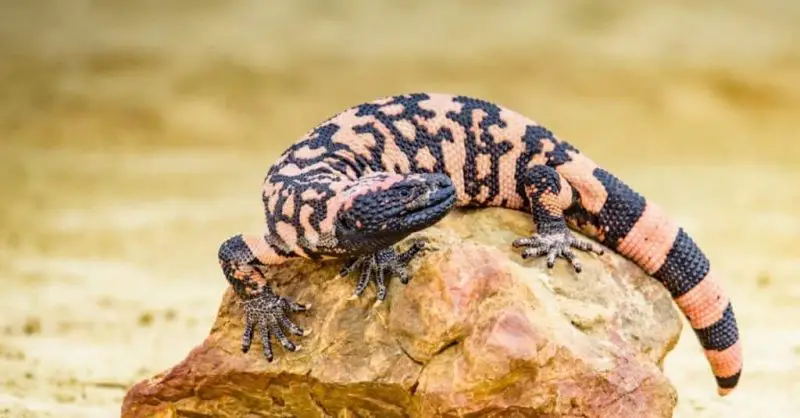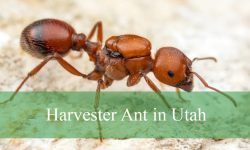Gila monsters stand out as some of the most mysterious and misunderstood reptiles living in the Arizona desert. Their thick beaded skin, lumbering movements, and vibrant black-and-orange patterns have fascinated scientists for decades, yet very few people ever encounter them in the wild. These slow-moving lizards live in some of the harshest terrain in the Southwest, hiding beneath desert rock shelves, burrows, and thorny vegetation where summer temperatures can soar above 110°F. Despite their fearsome reputation and status as one of the few venomous lizards on Earth, Gila monsters are incredibly secretive animals with complex behaviors and remarkable desert adaptations.
Arizona remains the stronghold of Gila monster populations, particularly in regions such as the Sonoran Desert, the rugged foothills of Tucson, the Tonto Basin, and the vast Saguaro National Park. Their survival depends on specialized traits—venomous bites, seasonal feeding cycles, moisture conservation, controlled energy expenditure, and subterranean sheltering. Yet many details about their biology remain unknown to the general public.
Below are nine hidden facts about Gila monsters in the Arizona desert that reveal just how extraordinary these reptiles truly are.
1. Gila Monsters Spend Up to 95% of Their Lives Underground

Burrows Help Them Survive Extreme Heat
Arizona summers reach temperatures too hot for most reptiles to remain active during the day. Gila monsters escape the heat by retreating into underground burrows where temperatures remain far more stable. These burrows may be natural cavities, abandoned rodent tunnels, or spaces beneath large desert rocks.
Spending the majority of their lives underground helps them avoid dehydration and overheating.
This subterranean lifestyle is essential for long-term survival in the Sonoran Desert.
They Use Burrows of Other Animals
Rather than digging their own extensive tunnels, Gila monsters often rely on burrows created by packrats, kangaroo rats, ground squirrels, and other small mammals. These animals create deep, insulated chambers that the lizards later occupy.
This behavior saves the Gila monster energy—important in an ecosystem where food is difficult to find consistently.
Borrowed burrows also protect them from predators like coyotes and raptors.
Burrows Support Moisture Conservation
Gila monsters lose water slowly due to their thick, beaded skin, but their underground shelters play an even bigger role. Humidity levels underground are higher than the desert surface, helping them conserve precious moisture.
Maintaining hydration is one of the greatest challenges for desert reptiles.
This hidden adaptation contributes significantly to their survival strategy.
2. Gila Monster Venom Is Delivered Through Grooved Teeth, Not Fangs
They Lack Hollow Fangs Like Snakes
While many people assume Gila monsters bite like rattlesnakes, their venom delivery system is fundamentally different. Instead of hollow fangs, they have grooved teeth in the lower jaw.
When they bite, venom flows along these grooves into the wound.
This method is slower but extremely effective.
Their Bite Is Designed to Hold, Not Strike
Gila monsters latch onto prey or threats with powerful jaws and may chew for several seconds. This chewing motion delivers venom gradually as it secretes from glands in the lower jaw.
Because they hold on, venom is more consistently delivered than in quick-strike predators.
This gripping behavior makes them appear more formidable.
The Venom Causes Intense Pain but Is Rarely Fatal
Human envenomation can cause swelling, vomiting, dizziness, and severe burning sensations. However, deaths are virtually nonexistent.
Their venom exists for subduing nest-bound prey, not for killing large animals.
The danger lies mainly in the prolonged bite rather than venom toxicity alone.
3. Gila Monsters Feed Only a Few Times per Year
Their Diet Is Highly Specialized
Gila monsters target calorie-rich foods: bird eggs, reptile eggs, baby mammals, nestlings, and the occasional carrion. These food sources provide significant energy in small packages.
This energy-dense diet supports long periods between meals.
Egg raids are a key survival strategy in the desert.
They Can Store Fat in Their Tails and Bodies
Gila monsters can consume up to one-third of their body weight in a single feeding. This massive intake helps them store fat that sustains them for months.
Their metabolism is slow, and their energy demands are low.
Fat storage is vital during droughts and food scarcity.
Their Seasonal Feeding Peaks in Spring
Spring is the breeding season for many desert animals, meaning bird and reptile eggs are abundant. Gila monsters take advantage of this brief window when food is available above ground.
The rest of the year, feeding is minimal.
This fluctuating diet reflects desert seasonality.
4. They Move Slowly, but Their Endurance Is Remarkable
Slow Movement Helps Conserve Energy
Gila monsters rarely move quickly unless threatened. Their typical pace is a slow, deliberate crawl that minimizes caloric expenditure.
Energy conservation is crucial when food is unpredictable.
Their slow gait is an adaptation, not a weakness.
They Can Travel Long Distances for Mating
During late spring, males may walk several miles searching for receptive females. Their endurance allows them to cover large territories despite their slow pace.
These journeys often occur at dawn or dusk to avoid heat.
Their endurance is much greater than most people assume.
They Can Climb Over Rocky Terrain
Despite their stout appearance, Gila monsters navigate rocky slopes, boulders, and washes with surprising ease. Their strong limbs grip surfaces effectively.
This climbing ability helps them access nests hidden on elevated terrain.
Their physical strength supports their specialized lifestyle.
5. Gila Monsters Use Their Tongue Like a Chemical Sensor
Their Tongue Detects Chemical Cues in the Air
Much like snakes, Gila monsters flick their tongue to gather chemical particles, then deliver them to the Jacobson’s organ in the roof of their mouth.
This organ interprets scent information, helping them locate prey or mates.
Their sense of smell is exceptionally sharp.
They Can Track Eggs and Nest Sites by Scent
Gila monsters rely heavily on scent to find hidden nests containing eggs. They detect chemical traces left by birds or reptiles as they move to and from their nests.
This skill allows them to locate food with high precision.
Their foraging ability is largely smell-based, not sight-based.
They Recognize Territorial Markers and Mates
Chemical signals also help males detect females in breeding condition. They follow scent trails through washes, desert shrubs, and canyon floors.
This chemical communication forms the backbone of their mating behavior.
Their sensory biology is more complex than it appears.
6. Their Skin Is Made of Bead-Like Osteoderms
Each Scale Contains a Tiny Bone
Gila monsters have small, bony beads—called osteoderms—embedded in their skin. These provide armor-like protection against predators and harsh terrain.
The texture gives them their distinctive, beaded appearance.
Their skin is one of the most protective in the reptile world.
The Armor Helps Them Push Through Brush and Rocks
Osteoderms reduce the risk of cuts or injury as Gila monsters crawl through thorny plants, rocks, and tight underground tunnels.
This structural protection is essential in rugged desert environments.
The armor also deters predators.
Their Coloration Serves as Warning Signal
Bright orange and black patterns warn predators of their venomous bite. This aposematic coloration is universally recognized across desert ecosystems.
The warning signals reduce predation attempts.
Gila monsters rely on visual intimidation as well as venom.
7. Gila Monsters Have a Strong Seasonal Rhythm Tied to Desert Climate
They Are Most Active During Spring and Early Summer
From March to June, Gila monsters emerge to feed, mate, and explore above ground. This period aligns with moderate temperatures and abundant food sources.
Their seasonal timing is essential for survival.
Activity drops sharply in extreme heat.
Monsoon Season Affects Their Behavior
During Arizona’s summer monsoon, Gila monsters may emerge briefly after rainstorms when temperatures drop. Moisture increases their tolerance for surface activity.
These rare appearances are unpredictable.
Their behavior is tightly linked to rainfall patterns.
Winter Brumation Occurs Underground
Gila monsters enter a state of reduced metabolic activity during winter, similar to hibernation but not as deep. They remain sheltered in burrows for months, emerging only on warm days.
This energy-saving state helps them survive cold nights.
Their annual cycle revolves around climate extremes.
8. Their Mating Rituals Are Surprisingly Intense
Males Engage in Wrestling Matches
Male Gila monsters compete by grappling, lifting, and rolling each other in dominance battles that can last an hour or longer. These matches rarely cause injury but determine mating rights.
The stronger male wins access to females.
These contests occur during peak spring activity.
Females Lay Eggs Once per Year
After mating, females lay 3–13 eggs in late summer, often in burrows or protected soil cavities. The buried eggs incubate for several months without further maternal care.
The hatchlings emerge in fall or early winter.
Their reproductive cycle is slow and energy-intensive.
Hatchlings Receive No Protection
Unlike mammals or birds, young Gila monsters fend for themselves immediately after hatching. They possess venom and functional defenses from birth.
Survival rates are low, but hatchlings are highly capable.
Their independence reflects reptilian life strategies.
9. Gila Monsters Play a Critical Role in the Arizona Desert Ecosystem
They Regulate Small Animal Populations
By feeding on eggs and nestlings, Gila monsters help maintain balance among desert species. Without this predation, certain populations could grow unchecked.
Their role is subtle but impactful.
They are natural regulators of desert food webs.
They Serve as Prey for Larger Predators
Despite their venom, Gila monsters are vulnerable to coyotes, raptors, and bobcats. These predators help maintain population stability.
Predation pressure shapes their secretive behavior.
Their interactions contribute to ecosystem complexity.
Their Burrow Use Supports Soil Health
By occupying and modifying underground spaces, Gila monsters contribute to soil aeration and microhabitat creation.
These effects benefit insects, small mammals, and other reptiles.
Their ecological value extends beyond their fearsome reputation.
FAQs About Gila Monsters in Arizona
Are Gila monsters dangerous to humans?
They can deliver a painful bite, but human fatalities are virtually nonexistent.
Do Gila monsters chase people?
No. They avoid confrontation and move slowly.
How often do Gila monsters eat?
Only a few large meals per year.
Can Gila monsters climb?
Yes. They climb rocks, ledges, and vegetation.
Where can I see them in Arizona?
Sonoran Desert areas, including Saguaro National Park, Tucson foothills, and desert washes.
How strong is their venom?
Painful but not typically life-threatening.
Are Gila monsters protected?
Yes. Killing or capturing them in Arizona is illegal.
Do they hibernate?
They brumate in winter, remaining underground for long periods.
Conclusion
Gila monsters in the Arizona desert are far more fascinating than their rare appearances suggest. Beneath their intimidating reputation lies a reptile perfectly adapted to desert extremes—spending most of its life underground, storing energy for months at a time, detecting chemical trails with astonishing precision, and delivering venom through a unique grooved-tooth system. Their slow pace masks surprising endurance, strength, and ecological significance, making them one of the desert’s most remarkable inhabitants.
Understanding these nine hidden facts reveals how deeply Gila monsters are woven into Arizona’s ecosystems. Their survival depends on maintaining healthy desert habitats, stable burrow systems, and long cycles of seasonal behavior. Protecting these reptiles means preserving part of the ecological integrity that makes the Arizona desert one of the most biologically rich regions in North America.






